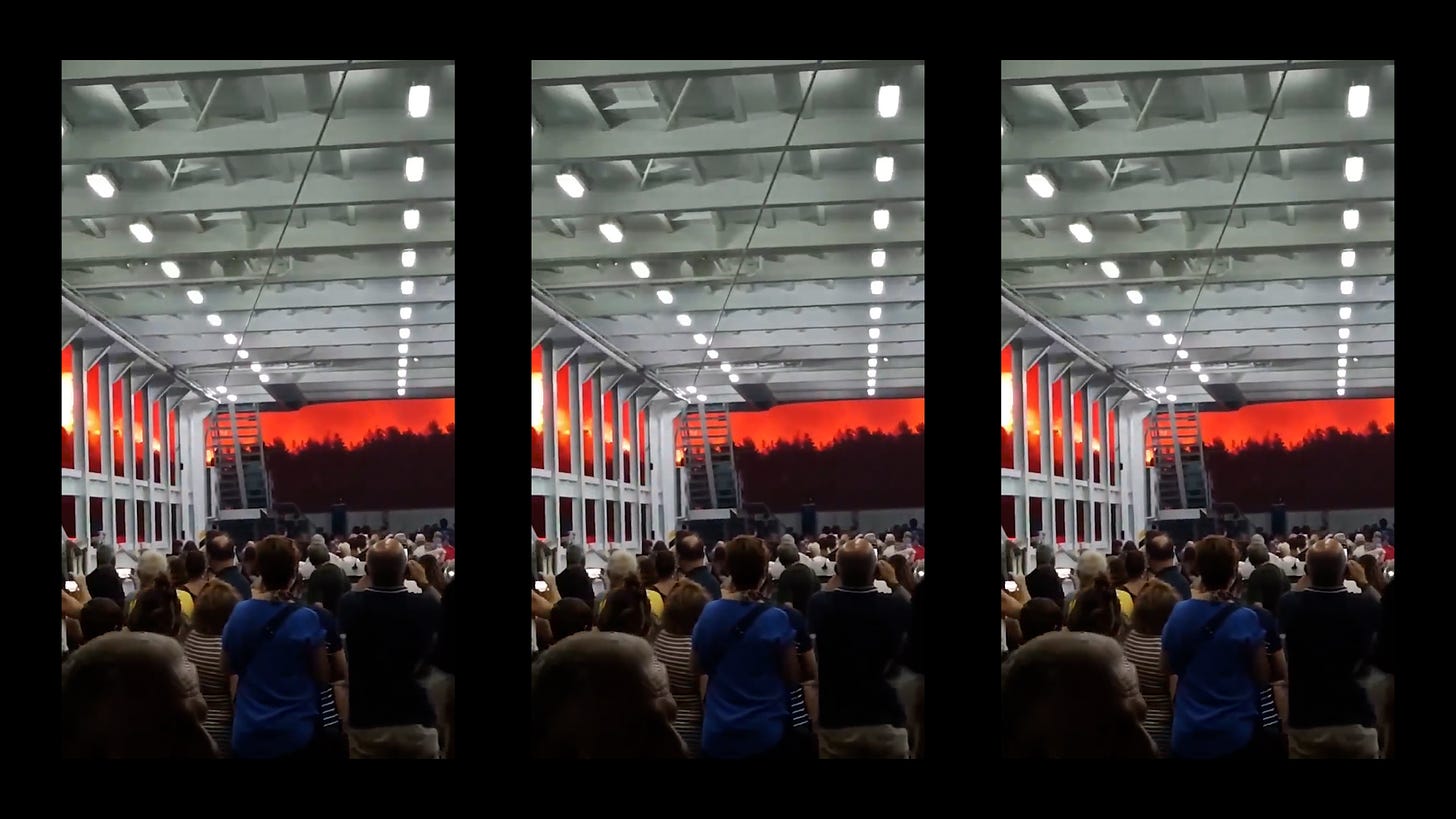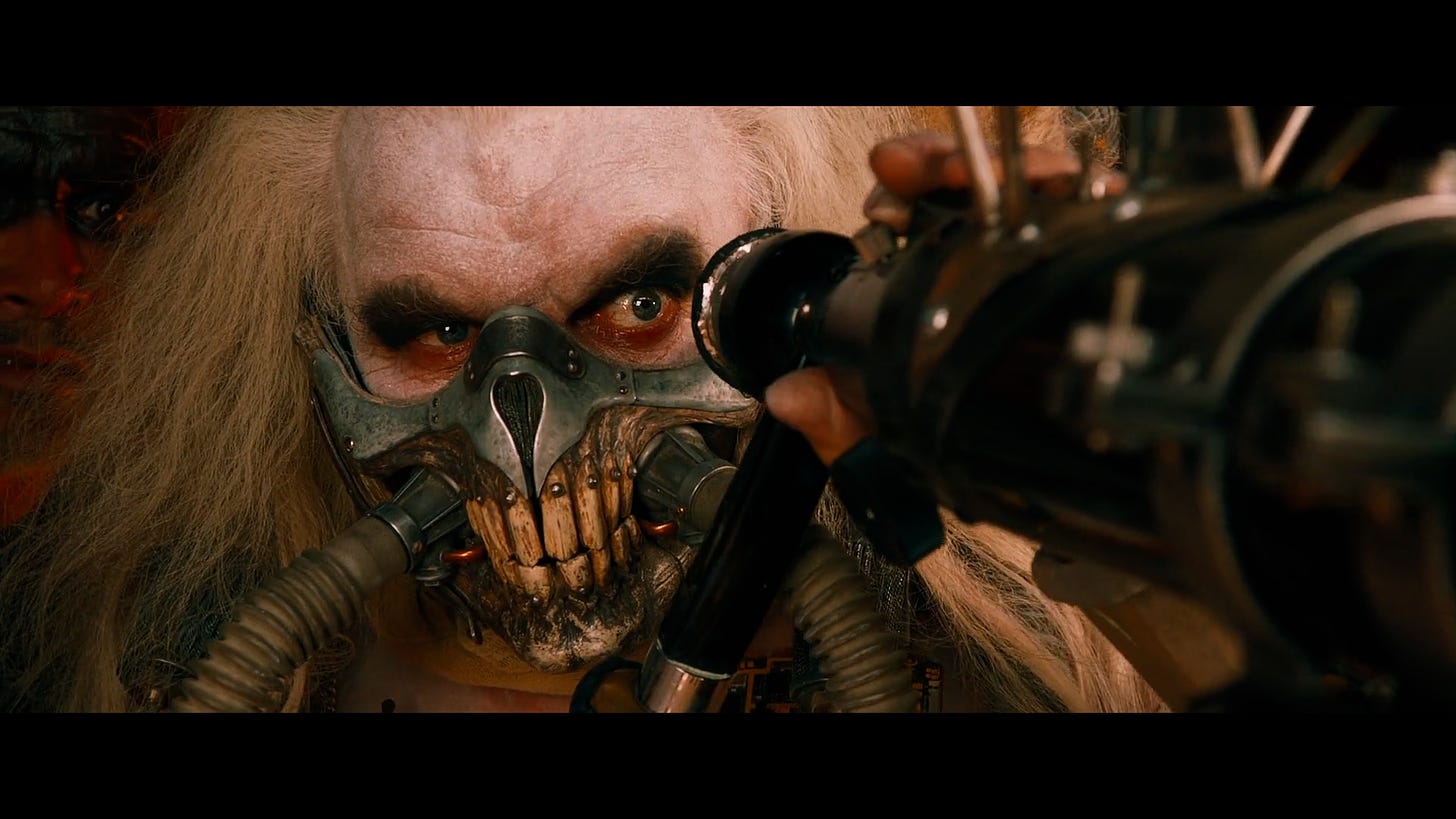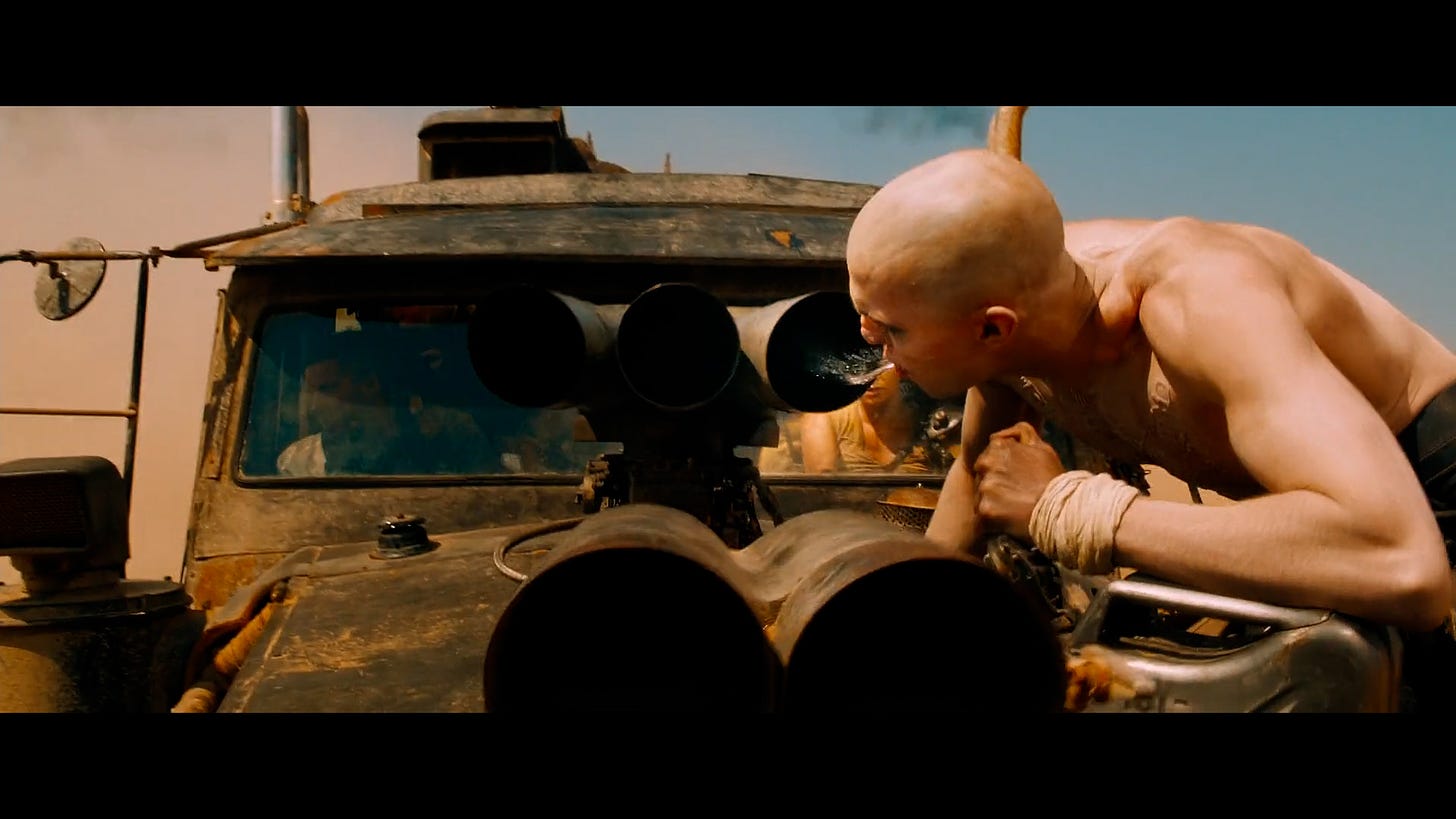Vroom Vroom: Mad Max, Automobility and Wildfires
An Essay About the Climate and Kate Beckinsale
This fortnight’s review is an essay about Mad Max: Fury Road because I read the news coverage about the IPCC Report and got spooked, watched a dumb movie, and had some dumb thoughts. Plus I had to find a productive way to express all my feelings about cars. As usual, the video is below and the text is below that (if you’re old school).
2,000 words.
I have been thinking about wildfires. And floods, and heatwaves, and droughts, and freak storms. Two weeks ago, the IPCC—the International Panel on Climate Change—released a new report, The Sixth Assessment Report. Sixth of its kind since 1990, reports that collate climate science together for the purpose of influencing policy. The AR6, published two weeks ago, builds upon the findings of the AR5—published in 2013. Though for more reasons than I can express here, the AR6 finds much more strongly just how screwed we are. Global warming has increased, fastened, exploded since the industrial revolution, and fastened moreover since the mid 20th century. The ice on the planet is melting, sea levels are rising, the climate is forcing the weather out of whack and CO2 emissions must be curtailed if the drastic effects of climate change are to be slowed.
I for one, like many, did not find the recent news on the climate of the Earth a huge comfort. We must all do what we can as individuals and as constituents of local, regional, and national groups. Keep our eyes on COP26, the United Nation’s Climate Change Conference, set to take place in Glasgow later this year. In the meantime, there are always ways to become more informed. There are ways to process the catastrophic events on Earth. Read the (climate) news, look at (Greta Thunberg’s) Twitter, read dumb (The Ecologist) magazines, go see an (Eco-Art) exhibition, a (climate documentary) movie, or read a (Naomi Klein) book. I watched Mad Max: Fury Road, a post-apocalyptic road movie directed by George Miller in 2015. The film stars; thot-boy Tom Hardy as Max, an ex-cop, and please-step-on-my-neck Charlize Theron as Imperator Furiosa. She is a ‘War Rig’ driving amputee tasked with the transportation of ‘Guzzolene’ across the desert wasteland from one cult business leader to another. Her employer is Immortan Joe, an asthmatic leader with a dermatological condition. Furiosa breaches her contract when she instead smuggles five of Joe’s wives out of the Citadel in search of the ‘Green Place’ and the ‘Many Mothers’. The film is famously plot-lite. The group drive, and are chased, out across the desert and gets stuck, then unstuck, and drive back.
I am going to be honest and upfront. I hate cars. I hate everything about them. I think most of them look bad, they cost too much, demand attention and budgeting from government. Cars are terrible. Not great for the environment, the machines encourage an individualistic approach to a manufactured idea of freedom. Moving around a walkable city shouldn’t feel like sucking on an exhaust. And the majority of the space shouldn’t be occupied for the provision of machines in the form of; roads, car parks, motorways, petrol stations, and on-street parking spaces. All have been allocated to the car, the almighty car. Many of us live in a culture where to own a car is to be mobile, to be without one is to be disadvantaged. And what appears to be most unsettling is the public’s unwillingness to reckon with the compulsory mandating of the automobile. So much infrastructure has been built around the car, it is difficult to imagine space without it.
The characters in Mad Max: Fury Road cannot move—neither themselves nor through the narrative—without the use of an automobile. The story is set in the future after a huge societal collapse following environmental devastation by an onset of oil and water wars. An opening voice-over by far-away news reporters report of a ‘thermo-nuclear skirmish’, that ‘our bones are poisoned’, and ‘we have become half-life.’ The water and oil conflicts equate a biological necessitated resource with a societally mandated other. The two are equal. Without either, the people of the Mad Max world cannot survive. No character, hero or villain, moves without the machine.
There is an emphasis on the mechanical in the film. Max asks Nicholas Holt’s character, Nox—a converted ‘War Boy’ of Immortan Joe’s—if he is a ‘black thumb’. An engine had blown in the two-engined War Rig. A play on the American English idiom ‘green thumb’ meaning a natural penchant for gardening. The characters have more opportunity, in this future, to develop a knack for mechanical engineering on account of the little green space found in the environment. Because there is nothing else, the mechanical sits in lieu of everything else. The image of the machine replaces all else.
I’m not going to pretend I have extensive knowledge of the visual-cultural representations of automobiles, but I’ve watched a couple of movies with cars in them. Our environment is in such disarray because we are fed many conflicting images at once. The car, the machine is; toxic, glamorous, hot, macho, practical, familial, life-saving, accident-prone, world-destroying, and magic. Now, again, I’m not saying I have seen every movie with a car in it, but I know that The Fast and The Furious was made. I think I understand the concept. Cars go vroom. The concept is cars. I was watching the 2021 action comedy film Jolt, featuring the iconic Kate Beckinsale, and there is a scene where her character steals a sports car. The machine is something to be idolised, desired, and masterful of. The scene is coupled with a panning aerial shot of the city—the arterial system illuminated in streetlamp along its gridded roads. We are no less capable than the characters in Mad Max: Fury Road of moving without cars. Our cities and suburbs and all other residential and commercial spaces are entwined with and reliant on road transportation.
The Mad Max world like our own is a world of automobility. Coined by the sociologist John Urry in the early 2000s, automobility is the enmeshing of people with machinery, namely cars. It is the supposed freedom, mastery, ease, and dominance of the car. The term comes from the smashing of auto, as in autoeroticism, as in the self, the person, with automation, automatic, with propulsion through space, with the car. Urry wrote in the 2006 essay Inhabiting the car, “This double resonance of ‘auto’ is suggestive of how the car-driver is a ‘hybrid’ assemblage, not simply of autonomous humans but simultaneously of machines, roads, buildings, signs and entire cultures of mobility.”
Yes, cars are bad. Hardly a radical standpoint. Yet most people think or know that cars are bad and, still, they drive them. Cars are so well incorporated into our culture that the only alternatives are low emission hybrids and electric cars. These technological alternatives supposedly absolve drivers of the environmental cost associated with automobile ownership. It doesn’t, unfortunately. Annoyingly there is the Jevons paradox. First observed in the mid 19th century by William Stanley Jevons, the economist, around the time of the Watt steam engine. The Jevons paradox occurs when technological advancement, like new steam engines, increases the efficiency of resource consumption, like coal, but the rate of consumption does not decrease, resources are consumed at a higher rate due to increased demand. A new engine that is more efficient will be in higher demand, to get more goods manufactured and transported faster, and so the demand for the resource it consumes will increase too. Ergo a machine that consumes less fuel has not contributed to the decrease of that resource. Driving a hybrid car doesn’t save consumers fuel, it only paradoxically increases their driving habit. Most assume, from environmentalists to governments, that there will be a net decrease in CO2 emissions overall, that the paradox will not occur. The Jevons paradox is highly debated in environmental economics. I don’t suppose to know all the answers. I’m only writing a Mad Max: Fury Road essay.
What appears most paradoxical in Mad Max: Fury Road is the Many Mothers. It is explained in a series of small samplings of exposition that Furiosa grew up with the Many Mothers. A biker gang group of women who, according to Furiosa, live in the Green Place. A place in the barren environment where plant life grows. The group are portrayed as rebels, radicals, they are rightly suspicious of men, and are concerned with growing food sustainably and making sure ‘everybody got their fill.’ First, while in pursuit, the wives, Nox, Furiosa, and Max have to cross a bog populated with ‘creepy crows’ that stand on stilts. While crossing their War Rig gets stuck in the mud. Rear tires sunk into the bog. Nox, the retired War Boy, has the idea to run a chain from the front of the rig around a wasted-away tree. He says, “There’s high ground, just beyond that thing,” he’s pointing with one had to the tree. Capable, played by Riley Keough, one of the escaped wives clarifies, “he means the tree.” Nox doesn’t know what a tree is, and in an ironic sequence, the group hoists the heavy machine out of the mud while pulling the tree’s roots from the earth. It is revealed, after their escape, and after meeting with the Many Mothers, that the bog was once the Green Place where Furiosa had expected them to be. A place now devoid of life, where the deadened outline of a tree is only useful for pulling trucks from the bog.
The Many Mothers all drive motorbikes and carry weapons. The conditions the women live in are hostile and so to survive one has to be equally hostile. The characters are all reliant on machinery, especially weapons. In a cross-generational conversation between Wive and Mother; The Dag played by Abbey Lee, and Keeper of the Seeds played by Melissa Jaffer; the two discuss violence. Jaffer’s character is cleaning a rifle. The younger asks, “you kill people with that, do ya?” She replies, “killed everyone I ever met out here.” The Dag retorts, “somehow thought you girls were above all that.” The Keeper of the Seeds invites Lee’s character to look in her bag, a traditional medical bag, full of glass bottles and bags containing seeds. She posits that nobody had to ‘snap’ each other, “back when everyone had their fill.” When there were amble resources for everyone, there was less violence. The women have resorted to violence because demand for resources is so high. Their conversation mirrors the mentions of oil and water wars from the voice-over at the beginning of the film. The devastation the world has succumbed to is the result of inequality, extortion, and exploitation. To survive the world is to engage in violent, exploitative practices.
There’s an interesting sentiment throughout the film, it is graffitied on the walls of the Wives’ prior home—inside a locked vault—and said aloud later in their escape.
Who killed the world? We now appear to be living through a turn. Where the question will be asked, and is being asked now, who killed the world? I can’t know that Mad Max: Fury Road is a prophetical film; it would be pretty devastating and humiliating if it was. Yet we are seeing loss of land, droughts, wildfires, devastation, famine, rising inequality; all within our lifetime; that is only expected to worsen without action. Playing by the rules of the world for survival is necessary when there are raving warlords trying to kill you in the desert. Yet who killed the world, if not all of us? I’m grappling with a sentiment I see quite often, where environmentalist action is out of the hands of ordinary people. If we are to see any change it must come from big business. What I struggle with is that, like cars, we have built countless systems around environmental decay. It will take total cooperation from everyone to enact change. Which begins with individual action and representative pressuring. I believe we all have something to do. Automobility is machines enmeshed with people, in all our systems, in all our spaces. It is with the slow untangling of these reliances—of people’s reliance on cars, motorways, and signs, exclusively for mobility, to give but one example—that radical change can occur.
—Andy x






